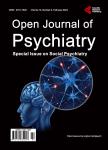Body Image Disturbance and Dissatisfaction, Scorn and Stigma in Severely Obese Individuals, a Case-Control Study
Body Image Disturbance and Dissatisfaction, Scorn and Stigma in Severely Obese Individuals, a Case-Control Study作者机构:The HUH Psychiatry Centre University of Helsinki Helsinki Finland University of Helsinki Helsinki Finland Carea Hospital District Kymenlaakso Psychiatric Hospital Kuusankoski Finland
出 版 物:《Open Journal of Psychiatry》 (精神病学期刊(英文))
年 卷 期:2018年第8卷第3期
页 面:355-375页
学科分类:1002[医学-临床医学] 100214[医学-肿瘤学] 10[医学]
主 题:Body Dissatisfaction Body Image BMI Draw a Person Machover Index Obesity Overweight Rorschach Variable Scorn Stigma Weight Misperception Weight Perception Wholeness Index
摘 要:Background: The obesity rate is rising. The aims of this study were to elucidate the connection among body image disturbance and dissatisfaction, scorn and stigma in severely obese individuals using a case-control method. Method: The study group consisted of 112 individuals receiving permanent disability pensions primarily for obesity. The controls were selected by random sampling. The controls were matched with the subjects by place of residence, gender, age, the time since the pension was granted and occupation. Psychiatric interviews and psychological assessments were conducted with all participants. The results were analyzed via chi-squared tests (χ2-tests) and percent distributions. The subject and control groups were compared via paired t-tests. Conditional logistic regression analysis was also conducted. Results: In the Draw a Person test, we found disorganization of the body image to some degree in the subject group. Some significant differences were found between the Machover index and the wholeness index. The Rorschach variables obtained some differences in the responses between the subject and control groups. Obesity was a problem in all age groups. In the study group, half of the participants thought that they were obese. Most of the participants had endured scorn and contempt directed at them due to being overweight. Conclusions: We believe that our study provides a novel and necessary overview of the connection among body image disturbance and dissatisfaction, scorn and stigma.



